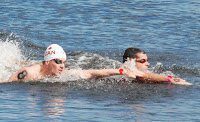 After watching triathletes and amateur swimmers throughout the year enjoying the open water, it is always impressive to watch the athletes at the world open water swimming championships.
After watching triathletes and amateur swimmers throughout the year enjoying the open water, it is always impressive to watch the athletes at the world open water swimming championships.
While it is unfair to compare the aerobic capacity, strength and power of the young world-class athletes with older swimmers, it is often educational to identify different parts of their stroke for comparison purposes.
One technical difference between a world-class athlete and an amateur is the hand entry and catch. From our observations, testing and analysis, it appears the hand entry and catch play a large role in determining one’s navigational abilities in the open water.
For those whose hand entry and catch are symmetrical on both the left-hand and right-hand sides, they swim straighter in the water – all other things being the same (head position, breathing, kick). Swimming straight along the tangents from buoy to buoy are critical for any level of competition, but especially so at the world-class level. Additionally, those whose hand entry and catch are either too far left or too far right or unbalanced, they seem to get hit more in a pack. That is, their inability to swim straight – even in a pack – leads them to initiate contact with their competitors. This increased propensity of physicality in the water is especially critical at the end of a race when every ounce of energy and speed are required.
There are several other factors that influence one’s ability to swim straight, but we did notice the difference in this one aspect of the arm stroke.
Photo by Steeve Tremblay at the World Open Water Swimming Championships.
Copyright © 2010 by Steven Munatones